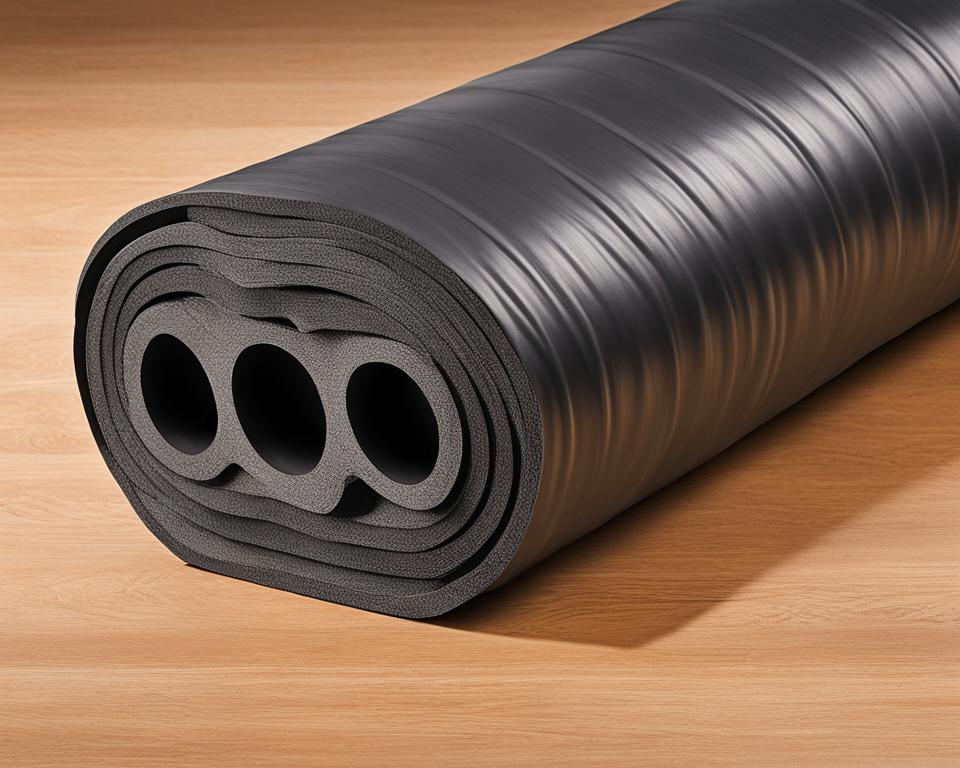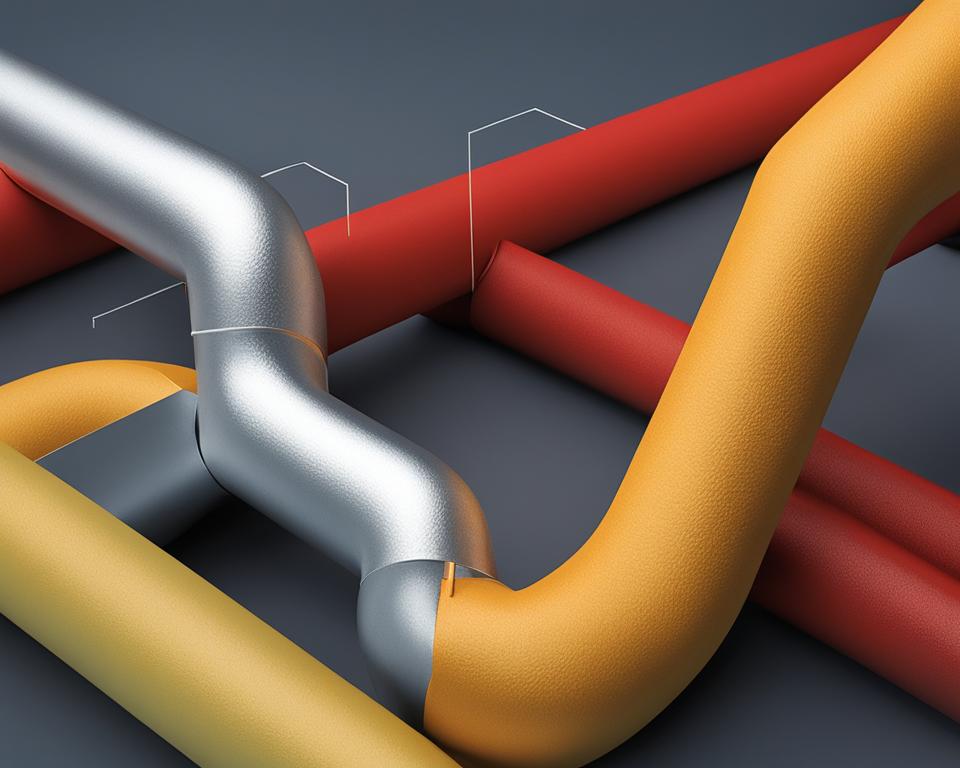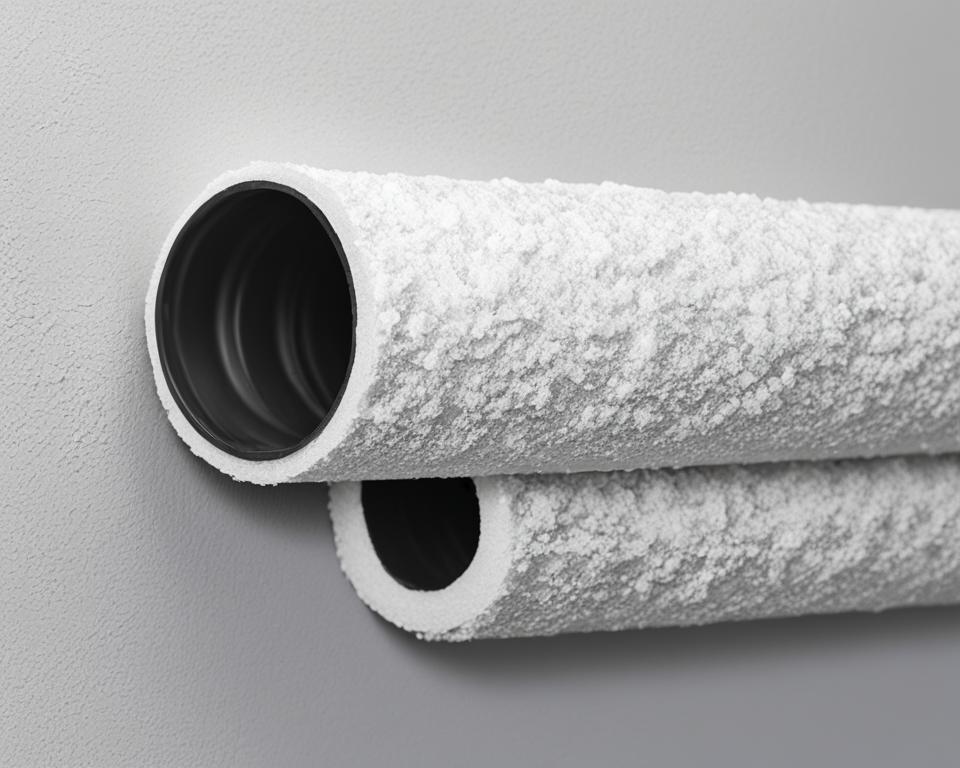When it comes to AC pipe insulation, making the right choice is crucial for ensuring energy efficiency, temperature control, and overall system performance. Two popular options for AC pipe insulation are foam and rubber. Each material has its own unique characteristics and benefits, so it’s important to understand the differences and choose the one that best suits your needs.
Key Takeaways:
- Foam and rubber are two common choices for AC pipe insulation.
- Foam insulation offers thermal efficiency and cost-effectiveness.
- Rubber insulation, particularly EPDM, provides higher temperature tolerance and better fire safety ratings.
- Consider factors such as thermal conductivity, temperature tolerance, fire safety, and cost when deciding between foam and rubber insulation.
- EPDM rubber is preferred for commercial and industrial applications, while foam insulation is suitable for residential and light commercial use.
Understanding Foam Pipe Insulation
When it comes to AC pipe insulation, foam pipe insulation is a popular choice due to its thermal efficiency and cost-effectiveness. Made from flexible elastomeric closed-cell foam, this insulation material is composed of synthetic rubber.
Foam pipe insulation is available in two main formulations:
- Nitrile Butadiene Rubber with PVC (NBR/PVC): This formulation combines the excellent thermal insulation properties of nitrile rubber with the durability and flexibility of PVC. NBR/PVC foam pipe insulation is known for its resistance to oils, chemicals, and UV radiation.
- Ethylene Propylene Diene Monomer (EPDM): EPDM foam pipe insulation offers high resistance to heat, ozone, and weathering. It is suitable for outdoor applications and provides excellent thermal insulation.
Foam pipe insulation is widely used in various applications, including commercial and industrial HVAC systems. Its closed-cell structure prevents moisture ingress and ensures optimal insulation performance.
For a better understanding of the differences between foam and rubber insulation, let’s compare them in a table:
| Aspects | Foam Insulation | Rubber Insulation |
|---|---|---|
| Thermal Efficiency | High | High |
| Temperature Tolerance | Good | Excellent |
| Fire Safety | Good | Better |
| Durability | Moderate | High |
| Cost | Lower | Higher |
As shown in the table, foam insulation offers good thermal efficiency, temperature tolerance, and fire safety ratings. It is a cost-effective option suitable for residential and light commercial applications. On the other hand, rubber insulation, especially EPDM, excels in temperature tolerance, fire safety, and durability, making it the preferred choice for commercial and industrial settings.
In the next section, we will explore rubber pipe insulation and its unique characteristics, comparing it to foam insulation.
Exploring Rubber Pipe Insulation
When it comes to AC pipe insulation, rubber insulation is another popular choice, offering different performance characteristics compared to foam. Rubber pipe insulation, particularly EPDM rubber, is known for its durability, higher temperature threshold, and better fire safety ratings.
Unlike foam insulation, which is composed of synthetic rubber, rubber pipe insulation also features a closed-cell structure. This makes it an excellent choice for commercial and industrial applications where thermal efficiency and safety standards are crucial.
EPDM Rubber Insulation
EPDM rubber insulation is widely recognized for its exceptional properties that make it ideal for AC pipe insulation. Its high temperature tolerance allows it to withstand extreme conditions, ensuring reliable and efficient operation of HVAC systems.
In addition to its ability to handle higher temperatures, EPDM rubber insulation also excels in fire safety. Its better fire safety ratings provide an added layer of protection, contributing to the overall safety of the AC system and the surrounding environment.
EPDM rubber insulation is also known for its durability. Its robust construction allows it to withstand the rigors of industrial settings, making it a top choice for applications that require long-lasting, reliable insulation.
| Comparison | Rubber Pipe Insulation | Foam Pipe Insulation |
|---|---|---|
| Temperature Threshold | Higher temperature tolerance | Lower temperature tolerance |
| Fire Safety Ratings | Better fire safety ratings | Standard fire safety ratings |
| Durability | More durable | Less durable |
As seen in the comparison table above, rubber pipe insulation, particularly EPDM rubber, outperforms foam insulation in terms of temperature tolerance, fire safety ratings, and durability. These qualities make it a preferred option for commercial and industrial applications where performance and reliability are paramount.
However, it’s important to consider specific project requirements and consult with professionals to determine the best insulation option for your AC pipes. This ensures that you choose the materials that provide optimal performance and meet industry standards.

Key Factors to Consider
When choosing between foam and rubber pipe insulation for your AC system, several key factors come into play. These factors will help you determine which option is the best fit for your specific needs and requirements.
Thermal Conductivity
One important factor to consider is thermal conductivity, which directly impacts the energy efficiency of your HVAC system. Foam insulation generally has a lower thermal conductivity compared to rubber insulation, making it a better choice in terms of heat resistance and energy conservation.
Continuous Service Temperature
Another essential consideration is the continuous service temperature, which refers to the upper limit that the insulation material can handle without compromising its performance. Rubber insulation, particularly EPDM, has a higher temperature threshold compared to foam insulation, making it suitable for applications that require greater heat resistance.
Fire Safety Ratings
Fire safety is a critical aspect when it comes to AC pipe insulation. Rubber insulation, especially EPDM, generally offers better fire safety ratings compared to foam insulation. This makes it a preferred choice for applications where fire safety is a primary concern, such as commercial and industrial settings.
Density
The density of the insulation material also plays a role in its overall performance. Foam insulation tends to have a lower density compared to rubber insulation. While lower density can provide flexibility and ease of installation, higher density can enhance durability and long-term performance.
Cost
It’s essential to consider the cost of both foam and rubber pipe insulation options. Foam insulation is typically more cost-effective compared to rubber insulation, making it a popular choice for residential or light commercial applications. However, the specific project requirements and desired performance may influence the final decision when it comes to cost considerations.
In conclusion, when choosing between foam and rubber pipe insulation, it’s crucial to evaluate factors such as thermal conductivity, continuous service temperature, fire safety ratings, density, and cost. Each material has its own advantages and considerations, and the best option will depend on your specific application and project requirements.

Comparing NBR/PVC and EPDM Rubber Insulation
When it comes to choosing insulation for air conditioning pipes, two common options in the rubber insulation category are NBR/PVC and EPDM. Each type has its unique characteristics and benefits, which can help in making an informed decision for your AC pipe insulation needs.
NBR/PVC Rubber Insulation
NBR/PVC rubber insulation is known for its thermal efficiency and cost-effectiveness. It is composed of nitrile butadiene rubber with PVC, making it a popular choice for various HVAC applications. Here are some key features of NBR/PVC rubber insulation:
- Good thermal efficiency
- Cost-effective
- Excellent flexibility
- Durable and long-lasting
- Resistance to moisture and UV radiation
- Effective noise reduction
These properties make NBR/PVC rubber insulation suitable for residential and light commercial use, where performance and affordability are crucial factors.
EPDM Rubber Insulation
EPDM rubber insulation, on the other hand, offers superior performance in specific areas, making it a preferred choice for demanding applications. Here are the notable characteristics of EPDM rubber insulation:
- Chemical polarity and oil resistance
- High water vapor permeability resistance
- Excellent UV resistance
- Mold and mildew resistance
- Wide temperature range compatibility
- Enhanced fire safety ratings
EPDM rubber insulation excels in industrial and commercial settings where durability, resistance to extreme conditions, and advanced fire safety are essential considerations.

Comparing NBR/PVC and EPDM Rubber Insulation
Here’s a table summarizing the key differences between NBR/PVC and EPDM rubber insulation:
| Property | NBR/PVC Rubber Insulation | EPDM Rubber Insulation |
|---|---|---|
| Thermal Efficiency | Good | Excellent |
| Cost-effectiveness | Yes | No |
| Water Vapor Permeability | Low | High resistance |
| UV Resistance | Good | Excellent |
| Mold and Mildew Resistance | Yes | Yes |
| Fire Safety Ratings | Standard | Enhanced |
| Temperature Range Compatibility | Wide | Wide |
Understanding the differences between NBR/PVC and EPDM rubber insulation can help you select the most suitable material for your AC pipe insulation needs. Consider factors such as thermal efficiency, cost-effectiveness, water vapor permeability, UV resistance, mold and mildew resistance, fire safety ratings, and temperature range compatibility to make an informed decision.
Conclusion
When it comes to AC pipe insulation, making the right choice between foam and rubber insulation is essential. Both materials have their own unique qualities that cater to different needs and applications.
Overall, foam insulation is a cost-effective option that works well for residential or light commercial settings. It provides good thermal efficiency and is easy to install. However, for more demanding environments, such as commercial and industrial settings, rubber insulation, particularly EPDM, is the preferred choice. It offers superior thermal efficiency, higher temperature tolerance, and better fire safety ratings.
Before making a decision, it’s important to consider factors such as thermal efficiency, temperature tolerance, fire safety, and cost. Evaluate your specific requirements and project needs to determine which type of insulation is the best fit for your HVAC system. Whether you choose foam or rubber insulation, proper insulation is crucial for optimizing energy efficiency and ensuring the longevity of your AC pipes.
FAQ
What are the main choices for AC pipe insulation?
The main choices for AC pipe insulation are foam and rubber.
What is foam pipe insulation?
Foam pipe insulation, also known as flexible elastomeric closed-cell foam, is composed of synthetic rubber and comes in two main formulations: NBR/PVC and EPDM.
What is rubber pipe insulation?
Rubber pipe insulation is another popular choice for AC systems and offers higher temperature tolerance, better fire safety ratings, and increased durability compared to foam insulation.
What factors should I consider when choosing between foam and rubber pipe insulation?
Factors to consider include thermal conductivity, continuous service temperature, fire safety ratings, density, and cost.
What are the different types of rubber insulation?
The two most common types of rubber insulation are NBR/PVC and EPDM, each with its own advantages and performance characteristics.
